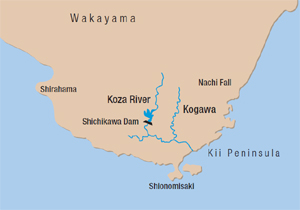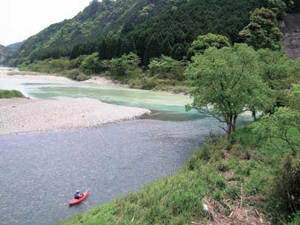Ocean Newsletter
No.94 July 5, 2004
-
Cultivating mental forests through hands -on experience - Activities to create three forests "Forests are lovers of the sea" -
Shigeatsu Hatakeyama Representative, Society to Protect the Forests for Oysters
By virtue of the "Forests are lovers of the sea tree-planting ceremony" that started in 1989, 30,000 broad-leaved trees of 50 species have been planted in the upper reaches of the Okawa River, which runs into Kesennuma Bay. However, our activities not only aim at the creation of upland and marine forests, but the thought that the cultivation of mental forests is the most important thing. I would like to introduce activities for the cultivation of children's mental forests through a hands-on learning classroom.
-
Kozagawa Project -Toward the creation of a research discipline for linkage studies of forests, the countryside, and the sea, and applying research results to society -
Yoshihisa Shirayama Seto Marine Biological Laboratory, Field Science Education and Research Center, Kyoto University / Selected Papers No.7(p.8)
The Koza River is a clear stream flowing through the Kumano region of Wakayama Prefecture, but the impact of the Shichikawa Dam - which exists for the purposes of flood control and power generation - on both the river and the river mouth during both ordinary times and times of heavy rain is not insignificant. The Field Science Education and Research Center of Kyoto University is attempting to clarify the impact of this manmade structure on the natural environment especially the linkage among forests, the countryside and the sea based on detailed data.
Selected Papers No.7(p.8) -
Clean, bountiful rivers, forests and oceans - Actions taken by the Katsura-Sagami River Basin Council -
Miwako Kuwagaki Representative, Katsura-Sagami River Basin Council
The Katsura-Sagami River, which runs from Yamanashi Prefecture to the central area of Kanagawa Prefecture and flows into Sagami Bay, has been supporting industrial development in adjoining cities but at present, important issues for environmental conservation are accumulating. The Katsura-Sagami River Basin Council is promoting the Local Agenda 21 of the Katsura-Sagami River Basin in order to build an environmental conservation-oriented society based on sustainable development, and to hand down the many blessings from the clean, bountiful Katsura-Sagami River to the next generation.
Kozagawa Project -Toward the creation of a research discipline for linkage studies of forests, the countryside, and the sea, and applying research results to society -
The Koza River is a clear stream flowing through the Kumano region of Wakayama Prefecture, but the impact of the Shichikawa Dam - which exists for the purposes of flood control and power generation - on both the river and the river mouth during both ordinary times and times of heavy rain is not insignificant. The Field Science Education and Research Center of Kyoto University is attempting to clarify the impact of this manmade structure on the natural environment, especially the linkage among forests, the countryside, and the sea, based on detailed data.
1. Necessity for a research discipline for linkage studies of forests, the countryside, and the sea
There has been growing public concern over the close linkage between marine ecosystems and terrestrial ecosystems. Because coastal environments are affected by all the integrated changes of terrestrial environments, concern is growing especially from the ocean side, as typified by the fact that fishing people are active in tree planting. However, it cannot be said that the linkage between forests and the sea through rivers has been fully clarified scientifically. For instance, it can be easily imagined that large schools of salmon swimming upriver in fall plays an extremely important role in the nutrient cycle of forest ecosystems in subarctic regions. However, to the best of the author's knowledge, in the case of Japan, where almost all the salmon that swim up rivers are caught for spawning at downstream areas under a salmon hatching project, there have been no materials publicized with regard to quantitative discussions as to how the project affects forests. It is possible that ayu(Japanese trout) and eels play a similar role as salmon in mid-latitude regions.
Under these circumstances, Kyoto University established the Field Science Education and Research Center in 2003, as one of three pillars to promote research on problems of the global environment. The Center is going to directly address the creation of a "discipline for linkage studies of forests, the countryside, and the sea" in order to clarify the close relationships between forest and coastal marine ecosystems, through rivers, as mentioned above, considering also the artificial impacts deriving from the countryside (or urban areas).
2. Linkage of the dam with forests, the countryside, and the sea

Though flood control dams have long played a socially useful role in their prevention of flood damage, it is pointed out that the decrease of river water and subsequent change in water quality negatively affect ecosystems along rivers. In addition, water discharged during times of heavy rain causes a drastic increase in water volume and subsequent drastic changes in water quality. It is thought that the artificial changes of the environments of rivers during ordinary times and in times of emergency seriously affect marine environments at the mouths of rivers. However, there is no example of a study that evaluates the good and bad points of dams from a comprehensive viewpoint in consideration of regional ecosystems, such as a linkage study of forests, the countryside, and the sea.
3. The Koza River System as a research model
The Koza River runs through the southeastern part of the Kii Peninsula, the Kumano area, and consists of its main river and a tributary river, the Kogawa. Though abundant natural areas remain in this region, that is to be registered as a World Heritage Site, the Shichikawa Dam has been constructed on the main river, primarily for controlling floods and generating power. The catchment basin of the Koza River is often hit by localized heavy rain from typhoons and the like, making the flood control function of the dam an important one. However, there have been several cases where ecosystems in the downstream area, especially at the river mouth on the sea side, were seriously damaged because of water that was discharged to protect the dam facilities, something which has prompted local residents to see the dam as a problem. Because of this, there is now a social need to discuss the advantages and disadvantages of the dam. From the standpoint of a linkage study of forests, the countryside, and the sea, it is almost impossible to treat scientifically most other rivers, due to their huge drainage areas and related diverse phenomena. However, as the Koza River system is manageble in size, and has the Kogawa as a contrasting river, problem establishment is considerably easier.
Furthermore, as a base for research on forests, the headstream area of the Koza River has a solid infrastructure of facilities for research. These include the experimental forests of Hokkaido University, the Kii Oshima Research Institute, and the Seto Rinkai Research Institute of the Kyoto University Field Science Education and Research Center. The headstream area of the Koza River is an extremely rare case, complete with ideal conditions for research on the relation between forests and marine ecosystems through the countryside area. For these reasons, the Field Science Education and Research Center selected the Koza River System as a model field in order to do comprehensive research on the area from the forest to the river mouth. It will also make proposals on the optimum positioning of the flood control dam and future comprehensive management of all elements of the drainage basin, including the forest area, the countryside, and the river mouth.
4. Differing water qualities and the results of preliminary investigations
 Photo 1: View of the confluence of the Koza main river
Photo 1: View of the confluence of the Koza main river
and its Kogawa tributary, seen from the Kogawa side.
The difference between the colors of the river waters is
obvious.
 Photo 2: Comparison of filters used in the Koza river:
Photo 2: Comparison of filters used in the Koza river:
from the main river (on the right) and the Kogawa River
(on the left)
The Center began its efforts by comparing the water quality of the main Koza stream and the Kogawa tributary in order to clarify the impact of the dam. Even visual observations indicate that running water in the main stream of the Koza River is severely turbid with a large amount of suspended matter. On the other hand, the Kogawa River is very clear, and the difference between them is evident at their meeting place, suggesting some impact from the dam (Photo 1). When actual water samples were collected and filtered, water from the Kogawa tributary had almost no particles caught by filters, whereas water from the main stream had large amounts of substances caught by filters (Photo 2). It can be said that the clarification of the substances is an important future research issue. In addition, we have found that the chemical properties of the river waters are different: water from
the Kogawa tributary, with a pH of approximately 6.8, is slightly acidic, while water from the Koza main river, with a pH of 7.1, is slightly alkaline. According to interviews with residents, various kinds of turbidity can be discerned. Greenish turbidity that is suggestive of green tea, found in the Kogawa tributary and the upstream area of the main stream after heavy rains has long been called "chanigori (tea-like turbidity)" by local people. There are also other kinds of turbidity, such as "shibunigori," which seems to be leachates from the forest floor, or a pool of stem flows, and appears temporarily during a light rain, and "sasanigori" in pale brownish green, which appears when the weather gets better. In addition, it is becoming clear that there are several kinds of artificial turbidity, including brownish turbidity caused by the collapse of slopes 1), and turbidity caused by clayish water that flows from the catch basins of paddy fields during the period of shirokaki 2) from March to May.
5. The future of the project
Local autonomous bodies and residents along the Koza River are highly interested in river management and the environmental impact of the Shichikawa Dam, and many residents from Kozagawa Town attended a briefing session held recently with regard to the content of our research. Encouraged by this, the Field Science Education and Research Center of Kyoto University would like not only to make the Kozagawa project a first step in the creation of a research discipline for linkage studies of forests, the countryside, and the sea, but also promote it as a model research project for the sharing of research results with the community by elucidating the linkages between dams and the marine environment.
1) Slopes include cut land and earth fills.
2) Shirokaki (also called takaki) means channeling water into paddy fields, and crushing and harrowing soil in preparation for rice planting.
